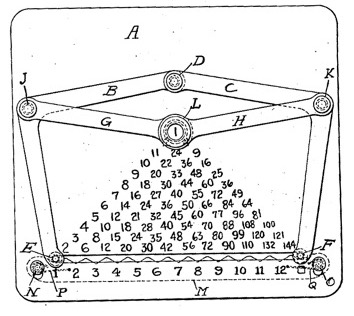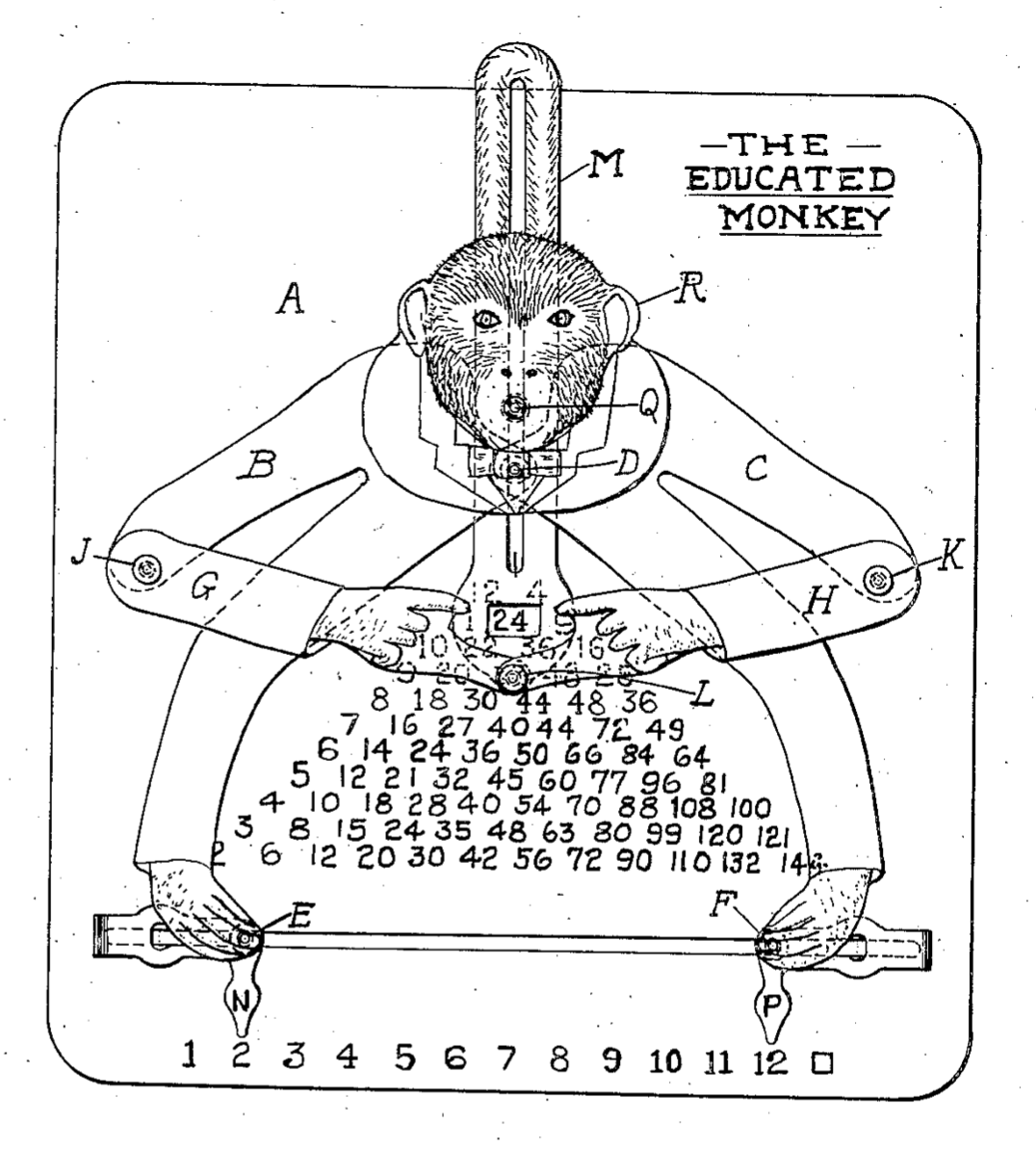- About MAA
- Membership
- MAA Publications
- Periodicals
- Blogs
- MAA Book Series
- MAA Press (an imprint of the AMS)
- MAA Notes
- MAA Reviews
- Mathematical Communication
- Information for Libraries
- Author Resources
- Advertise with MAA
- Meetings
- Competitions
- Programs
- Communities
- MAA Sections
- SIGMAA
- MAA Connect
- Students
- MAA Awards
- Awards Booklets
- Writing Awards
- Teaching Awards
- Service Awards
- Research Awards
- Lecture Awards
- Putnam Competition Individual and Team Winners
- D. E. Shaw Group AMC 8 Awards & Certificates
- Maryam Mirzakhani AMC 10 A Awards & Certificates
- Two Sigma AMC 10 B Awards & Certificates
- Jane Street AMC 12 A Awards & Certificates
- Akamai AMC 12 B Awards & Certificates
- High School Teachers
- News
You are here
Mathematical Treasure: Consul the Educated Monkey
On June 27, 1916, the Educational Novelty Company of Dayton, Ohio, received US Patent 1,188,490 for “‘Consul’ The Educated Monkey”, a tin mathematical linkage toy. Consul was invented by National Cash Register draftsman William Henry Robertson, who previously was a secondary math teacher. According to the instructions accompanying the toy, the Educated Monkey was designed to
- Teach the multiplication tables to 12s, associated elementary division, and associated elementary factoring.
- Teach the addition tables to 12s, and associated elementary subtraction.
When the monkey’s feet are set to point at two numbers, its fingers locate their product. The image shows the left foot pointing to 4, the right foot pointing to 9, and the hands pointing to the product 36. To square a number, the monkey’s left foot is set to point to the number, and the right foot is set to point to the symbol of a square; the fingers then locate the square of the number. To divide, one foot is set to point to the divisor, and the fingers are arranged to point to the dividend. The other foot then points to the quotient. To factor, the fingers are made to point at a product, and the feet then point to the factors.

“Consul,” the Educated Monkey, from the collection of Dr. Sid Kolpas.
For addition/subtraction, the toy comes with a cardboard addition table that is slipped under the monkey. Addition and subtraction proceed in a manner similar to multiplication and division.
A simulation of the Consul toy can be found at https://www.etudes.ru/en/models/educated-monkey/. A Windows simulation can be downloaded at https://www.ftcommunity.de/ftpedia/2015/2015-1/ftpedia-2015-1.pdf#page=19.
The instructions accompanying the toy indicate that it works due to the fact that the monkey is constructed around a plane mechanical linkage, and the products (sums) are arranged on the plate in a “special” order. The linkage consists of 2 upper arm/leg pieces (which ensures that moving the feet to different factors forces the hands to move), 2 arm/hand pieces, and a tail with an answer window which moves up and down with different products (sums). The 2 arm/hand pieces are attached to the tail, below the answer window. The 2 upper arm/leg pieces are attached to the 2 arm/hand pieces at the “elbow” and also to the upper part of the tail (the head of a monkey is attached on top of this). Moreover, the feet on the upper arm/leg pieces slide along the straight line opening at the bottom of the toy's plate.
Six months before he filed the patent application noted above, Robertson applied for a patent on a linkage intended to be used as a calculating device. US Patent 1,286,112 was also assigned to the Educational Novelty Company as soon as it was issued on November 26, 1918—Robertson served as president of the firm. Drawings from both patents are shown below. Unfortunately, the company had already gone out of business by 1917. The Educational Toy Manufacturing Company of Springfield, Massachusetts, purchased rights to Consul and made the example pictured above.


Editors’ Note: Historians have generally concluded that the character of Consul was chosen to evoke a series of chimpanzees (not monkeys) named Consul that were used in American vaudeville acts in the late 19th and early 20th centuries. Catherine Young [2016] is one of the scholars who has provided details on these performances, while Caitlin Donahue Wylie [2019] argued that the allusion and the finicky construction of the toy suggest this object was marketed more to parents anxious for their children to succeed at mathematics than to kids. Young is also among the researchers who have pointed out that Consul in his live and toy forms reinforced racist tropes about Black people that audiences were expected to recognize. The literature on stereotypes and other efforts during this time period to dehumanize Blacks in popular entertainment and consumer culture is voluminous; one overview is [Lemons 1977].
References
Kidwell, Peggy Aldrich. Consul, the Educated Monkey, or the inventions of William H. Robertson. O Say Can You See? Stories from the Museum. National Museum of American History, 29 June 2015. https://americanhistory.si.edu/blog/consul-educated-monkey-or-inventions-william-h-robertson.
Kolpas, Sidney, and Gary Massion. Consul, The Educated Monkey. Mathematics Teacher 93, no. 4 (April 2000).
Lemons, J. Stanley. Black Stereotypes as Reflected in Popular Culture, 1880–1920. American Quarterly 29, no. 1 (Spring 1977): 102–116.
Robertson, William H. Toy. US Patent 1,188,490, 27 June 1916.
Robertson, William H. Calculating Device. US Patent 1,286,112, 26 November 1918.
Wylie, Caitlin Donahue. What ‘Consul, the Educated Monkey’ Can Teach Us about Early-Twentieth-Century Mathematics, Learning, and Vaudeville. In The Whipple Museum of the History of Science: Objects and Investigations, to Celebrate the 75th Anniversary of R. S. Whipple’s Gift to the University of Cambridge, edited by Joshua Nall, Liba Taub, and Frances Willmoth, 237–256. Cambridge University Press, 2019. DOI: 10.1017/9781108633628.012.
Young, Catherine M. Animal Performance in Big-Time Vaudeville. Ph.D. diss., Graduate Center, City University of New York, 2016.
Sidney J. Kolpas (Delaware County Community College), "Mathematical Treasure: Consul the Educated Monkey," Convergence (December 2020)




